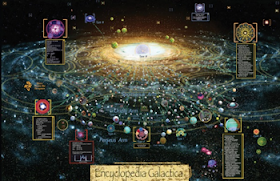 |
| Former #1 most visited blog post. Hierion Confinement |
Guilty. One of my guilty pleasures is going back into my old blog posts and editing them. Sometimes I add a hypertext link to a future blog post. I'll be indulging in this practice while I gaze back at ten of the most visited wikifiction blog posts. So, to the time machine and back to the beginning of the wikifiction blog...
2009
 |
| Grendels |
 |
| artist's depiction of Grean |
2010
 |
| image source |
Asimov and Aliens. The first printed science fiction story that I ever read was The Gods Themselves. For that novel, Asimov invented aliens who lived in another universe where the physical laws were slightly different than here in our universe. Since the day when I first saw an episode of Star Trek, I have believed that space aliens are the most fascinating characters and plot elements in science fiction stories. A good measure of a science fiction story writer is this: can you depict an interesting alien?
2011
 |
| Exodemic |
 |
| The Iidi |
In addition to the ancient past, the Exode Saga includes plot elements related to the far future. In particular, I've enthusiastically adopted Asimov's idea that we might be visited by time travelers from the future. Thus, the Exode Saga includes the character Trysta Iwedon who is an Asterothrope from the future.
 |
| Ivory investigates a cell bioreactor.
At Phari Base in the Slave Craton. |
With the Exode Saga backstory full of technologically advanced space aliens, a constant theme is the question: is the behavior of we Earthlings controlled by the aliens? The most visited wikifiction blog post for 2012 has long been Slavery in Science Fiction. My favorite slave-related story from the Exodemic Fiction Universe is in a blog post called Slave Craton. Were humans destined to be slaves since the first arrival of the pek on Earth billions of years ago?
2013
The most popular wikifiction blog post of 2013 is Post-Singularity Science Fiction. In the Exode Saga, I imagine that the Huaoshy exist as a very ancient life form which long ago achieved complete mastery of science and advanced technologies. Sadly, we Earthlings don't get to interact directly with the Huaoshy. They reside in the Sedronic Domain as artificial life forms.
 |
| Priscilla the pek |
 |
| image source |
2014
 |
| image source |
Four pages later, Noÿs adds, "We don't calculate alternate Realities. We view them. We see them in their state of non-Reality."
I could not resist making Reality Viewing an integral part of the Exode Saga. With time, I also made room for Reality Simulation, which allows for people to view events in Deep Time.
 |
| The End of the World, Clarke style. |
As of today, the most visited wikifiction blog post from 2015 is Syfy's Overmind. Most of my blog posts concern written science fiction stories and I don't enjoy most of the Sci Fi that graces television and film. Arthur C. Clarke's Childhood's End is a science fiction classic (1953) that presents us with Clarke's ideas about first contact with space aliens who are as far beyond we humans as we are beyond bacteria. Clarke's science fiction stories had a very strong influence on me and I like to celebrate his vision of aliens who might be impossible for we primates to understand.
2016
 |
| Nanomégas |
Some of the characters in the Exode Saga are nanoscopic, so I imagined that there might be Hierion Tubes that are so small only someone like Qaz can pass through them. I enjoy making illustration for my stories. Of course, it is a challenge to depict a character who is invisibly small.
 |
| by Don Martin |
The most visited blog post from 2017 is currently Don Martin. In general, science fiction story tellers should not take themselves too seriously. Growing up in the 1960s, I knew Don Martin for his cartoon illustrations in Mad magazine. In the late 1950s, Don Martin got paid to illustrate a few pulp magazine stories and I'm glad I discovered them in 2017. Martin died 20 years ago 😢, but judging by the number of page views for Don Martin, many people roam the interwebs in search of his artwork.
2018
 |
| The tryp'At Guide to Oxypathin |
Sturgeon was a high school dropout, so nobody should expect him to have had anything coherent to say about hormones and their roles in the human body. In Sturgeon's story, progesterone is used inhibit the hero from having sex with his wife. 😕
I'm going to blame Sturgeon for the fact that I have created additional fictional chemistry for the Exode Saga. Thus there is now oxypathin and frenchkissin, two neuropeptides that were originally part of Asterothrope biology but which also play a role in development of the the Mind Clone Network.
 |
| wikifiction labels |
The eighth most frequently used "label" for blog posts here at the wikifiction blog is "telepathy", so it is surprising to reach the end of this blog post and only now mention telepathy. I've been making a special effort here in 2019 to settle my thinking about the role of telepathy in the Exode Saga.
 |
| Vulcan telepathy. |
 |
| next |
Top 10 List from 2015
The annual wikifiction reviews - 2019 - 2018 - 2017
2016 - 2015 - 2014 - 2013
Next: Dune World by Frank Herbert
 |
| visit the Gallery of Book and Magazine Covers |






































